Script outlines.
If you’ve landed on this page, you want to know how to write one of your own.
Smart move, scribe.
That’s because outlining a script in advance comes with many benefits (like writing screenplays faster). So that’s what we’ll discuss first.
But if you want to skip ahead to the key plot points to include in a script outline, scroll down until you reach the subhead “How to Write a Script Outline with the 8 Essential Plot Points.”

Want to jump straight into the “how to” of writing a script outline? Scroll down till you reach this subhead.
A couple more introductory matters:
Although you’re curious about how to write a script outline, you might not actually be that keen on outlining. To you, it might feel overly restrictive.
Don’t worry. We’ll talk about that too. And with the method I’ll show you, you can enjoy the benefits of outlining—while still having the joy of discovering your story as you go along.
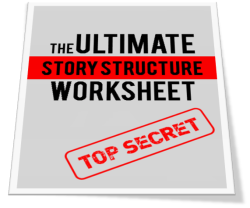
Also, I’ve created a free worksheet that will help you write a script outline using story structure (it’s a really popular resource that’s been downloaded over 37,000 times from writers around the world).
There’s a link to download it at the very end of this article, but if you want to grab it now, you can.
Click on this link to access my free 18-page story structure worksheet.
Last thing: this article is geared toward screenwriters. (You knew that already; the title gave it away *smile*).
But, whether you’re a screenwriter or a novelist, the benefits of outlining are the same. Plus, a well-structured novel is built on the same essential plot points as a screenplay.
So if you’re a novelist, I encourage you to stick around. Just ignore the parts where I talk about studio executives, and you’ll be all set.
Okay, with that introductory material taken care of, I’ll dive into the nitty-gritty of writing a script outline, right after the jump—so stay with me!
ARE YOU ON PINTEREST? Save the image below to one of your boards on Writing, Screenwriting, Plotting, or Story Structure. (When you hover over the image, a Pinterest save button will appear in the top-left corner. Click on that to save to Pinterest.)
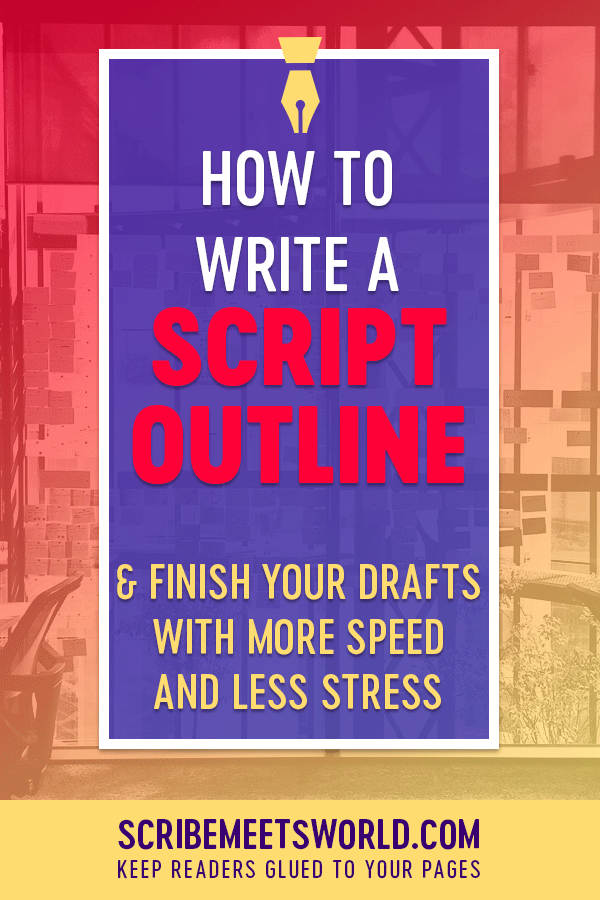
Why Take the Time to Write a Script Outline?
Outlining a script in advance comes with multiple benefits.
Although it might take a little time to write your script outline, you’ll save much more time in the long run.
How?
For starters, when you sit down to write your screenplay, you won’t waste hours staring at a blank computer screen wondering what happens next.
You’ll know. Through your outline, you’ll have a general sense of where your story is headed.
Without an outline, you might hit a wall halfway through your movie script. But with an outline, you won’t get stuck like that.
That’s because your outline will give you markers to reach—destinations to write toward.
Writing a screenplay becomes so much easier because it’s no longer you versus 120 blank pages.
You’re writing toward a goal—instead of blindly.
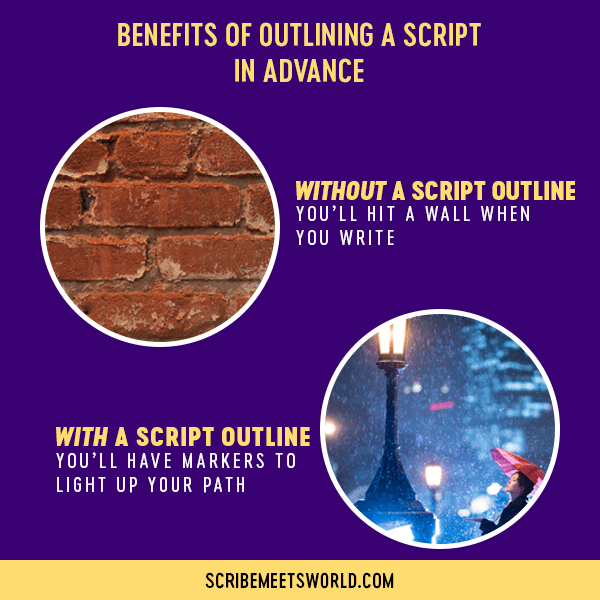
This is why you should learn how to write a script outline: no more dead ends.
That’s not all. When you write a script outline, you’ll be able to troubleshoot plot problems quickly. Once you identify an issue and generate an appropriate solution, you can just pop the solution into your outline.
As a result, the screenplay draft you produce based on your outline will be largely problem-free.
Which means that you’ll save time (and be less stressed) during the revision stage of writing.
To fix your script, you won’t have to spend months rewriting your entire screenplay from scratch, starting with page 1. Instead, you might be looking at a quick polish, something you can finish in a couple of weeks.
Basically, when you create a script outline in advance, you’ll save time:
- AS you write
- AFTER you write
In fact, with all the time you save, you might even be able to write an additional screenplay! Or, at the very least, you can use that time to create more script outlines. *fun*
As you can see, there’s a lot of benefits to writing a script outline. So let’s take a look at the basics of creating one…
What You Need to Understand to Create Script Outlines Like a Pro (And How to Embrace Outlining Even Though You Prefer to Write by the Seat of Your Pants)
Plot is the driving force of your screenplay.
Not character, not theme.
But plot.
To illustrate, let’s visit Charlie Sheen’s 2011 self-destructive spiral. (This may seem like a completely random choice. But it’s not—the first edition of this article was published in 2011, and since the example still works, it’s staying. *wink*)
Anyway, back to Charlie boy.
He’s an interesting character, that’s for sure. He’s someone people like to read and gossip about.
But would they want to spend 90 minutes of their lives watching him swill alcohol, do drugs, and oogle women?
I think not.
But give Charlie a goal—perhaps to rejoin Two and a Half Men, the successful sitcom he was kicked off of, while dealing with his addiction to alcohol, drugs, and women—that’s something people might actually watch.
They’d want to see whether or not he could pull it off.
Granted, maybe this isn’t something they’d pay $10 to see at the movie theater…but to stream on Netflix, why not?
Basically, with Charlie (character) and his flaws (theme), you’ve got material for a gossip column.
With Charlie (character + theme) and a goal (plot), you’ve got a story.
That’s why plot is the driving force of your screenplay. Having accepted that, you’ll want to know the dirty little secret about plot:

Keep this plot secret in mind when you’re working on your script outline
Yes, you heard that correctly. A thriller like The Bourne Identity has the same structure as a family comedy like Toy Story.
What do I mean by structure?
By structure, I’m taking about the critical turning points within your story. The load-bearing scenes.
There are eight of them. And if you use them as the foundation of your outline, you know that the plot of your screenplay will feel like an actual movie.
Plus—no matter your writing style—you will be in a hugely advantageous position.
If you’re a pantser, (someone who likes to write on the fly, by the seat of your pants), you’ll have structural markers to guide your path as you write. You won’t hit a wall halfway through your story. (And you won’t be looking at a major structural overhaul once you’ve finished your draft.)
At the same time, between your structural markers, there’s still plenty of unknown territory—plenty of your story left to discover.
Put another way, if you’re willing to make this compromise and figure out the structure of your story in advance…
You can enjoy the freedom of pantsing as well as the efficiency of outlining.
What if you’re a plotter, someone who already outlines your stories in advance? Then you can use the essential plot points to figure out the rest of your story (and really maximize your writing time). For instance, you could:
- write down on index cards the events that have to happen in order for each essential plot point to occur
- shuffle around your index cards to determine the best chronology of your scenes
- troubleshoot any problems you detect (at a time when it’s relatively painless to fix them)
Here’s the best part: if the essential plot points are in the right place, and if you execute them well, your story will have the roller-coaster rhythm that keeps readers hooked.
In sum, whether you’re a plotter or a pantser, with a loose outline (based on story structure), you can make out like a bandit.
Knowing how valuable story structure is to writing a script outline, you’ll probably want to take a closer look at these eight oh-so-crucial plot points.
I’m going to get to that soon. But first, we need to discuss something important. You see, before you can outline your script, you have to make sure your story is ready for that.
We’re going to talk about that next.
The Preliminary Step You Absolutely Must Take Before Writing Your Script Outline
Before you outline your script, you need to take a preliminary step.
You need to double-check that your idea has the six components that all compelling stories share.
This will make it easier for you to figure out the structural turning points that will make up your outline. Additionally, doing this now makes it far more likely that you’ll be investing your time in a strong, marketable concept.
What are these six components? Check them out (as well as quickie definitions), below:
- protagonist (the main character of your screenplay)
- goal (what your protagonist is trying to achieve)
- stakes (the bad thing that will happen if your protagonist fails)
- antagonist (the force that repeatedly thwarts the protagonist from achieving his goal; for best results, the antagonist should be a person—not nature, a flaw, or society)
- genre (the way your movie would be categorized; e.g. action, romance, comedy, fantasy, etc.)
- hook (elements that would convince an agent, studio executive, or moviegoer to invest time and/or money in your story)
Although I’d love to go into more detail about these, this article was getting plenty long already. I figured you’d prefer for me to dwell on the individual steps of creating a script outline based on story structure, so that’s what I did.
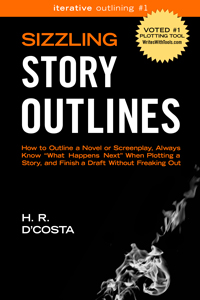
If you are interested in learning more about the six compelling components, that’s what Part I of my writing guide Sizzling Story Outlines is all about.
More details about this writing craft book (which was voted #1 Plotting Tool by WritesWithTools.com) can be found at the end of this article…
…but if you can’t just wait, click here.
How to Write a Script Outline with the 8 Essential Plot Points
To quickly recap, you’re going to build your script outline using story structure.
To get more specific, you’ll build your outline with these eight essential plot points:
- opening and closing images
- inciting incident
- first-act break
- midpoint
- fork in the road
- “all is lost” moment
- climax
- resolution
In other words, think of figuring out each structural turning point as an individual step in the process of creating an outline.
By doing this in advance, you’ll have markers to write toward, which should
- enhance your writing speed
- help you circumvent common structural plot problems
Ready to build a script outline together, step by step? Let’s do this!
Step #1: Pick images to begin and end your screenplay.
The opening image introduces your story to audiences, so make it a good one! Ideally, the first image is a visual representation of your entire screenplay.
Your closing image is your last contact with audiences. A strong closing image, like the spinning top in Inception, can even change the way audiences interpret the ending of your script.
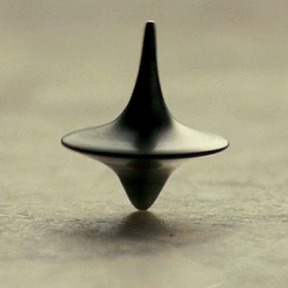
When you’re writing a script outline, you might choose a closing image like INCEPTION’s
Picking opening and closing images now, before you write your screenplay, will give you focus as you work on your draft. But, truth be told, this is one of the least essential plot points. So if you don’t know what to pick for your opening and closing images, don’t sweat it.
Keep in mind, even if you have a clear idea of what these images will be, you should re-examine them after you’ve got a solid draft under your belt.
Finalize your choices then, when you have a clear understanding of the theme you’re trying to convey in your script.
I must give credit where credit is due: I didn’t spend too much time thinking about opening and closing images until Blake Snyder mentioned them in his screenwriting book Save the Cat.
Step #2: Choose how your protagonist becomes embroiled in the plot with the inciting incident.
The inciting incident is the event that changes the course of your main character’s life.
If the inciting incident didn’t occur, your main character would’ve taken another path…and you’d have an entirely different screenplay.
As an example, at the inciting incident of Kung Fu Panda, Po is chosen to be Dragon Warrior.
The inciting incident tends to be:
- passive
- disruptive
- personal
- causally linked to the first-act break (more on that essential plot point in a sec)
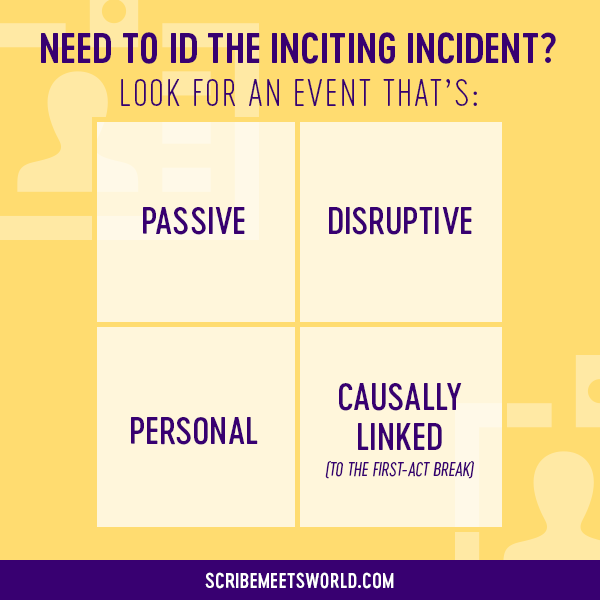
To identify the inciting incident, look for these 4 characteristics
For more info about these four characteristics, as well as examples of the inciting incident and how to use it to fix sluggish pacing, read this article on the inciting incident.
For a story structure worksheet that will help you pick a suitable inciting incident for your script outline (as well as the other essential plot points), click here.
Step #3: Send your protagonist on his journey at the first-act break.
The first-act break marks the end of your setup (i.e. groundwork). At this point, audiences know:
- who your protagonist is
- what goal he’s trying to achieve
- why this goal matters (i.e. the stakes)
- the antagonistic force that he’s up against
Now, at the first-act break, your protagonist will go on the journey that will help him achieve his goal (and, potentially, overcome his character flaw).
Oftentimes, the first-act break will involve a change in geographical location. For example:
- Axel Foley journeys from Detroit to Beverly Hills (Beverly Hills Cop).
- Margaret and Andrew journey to Sitka, Alaska from New York City (The Proposal).
- Elle Woods journeys from Southern California to Harvard (Legally Blonde).
See the first-act break in action in this clip from Beverly Hills Cop. (The money moment is at 2:03.)
Need extra help figuring out the first-act break for your screenplay? Preview (for free) Lesson 1.1. from my online course on story structure.
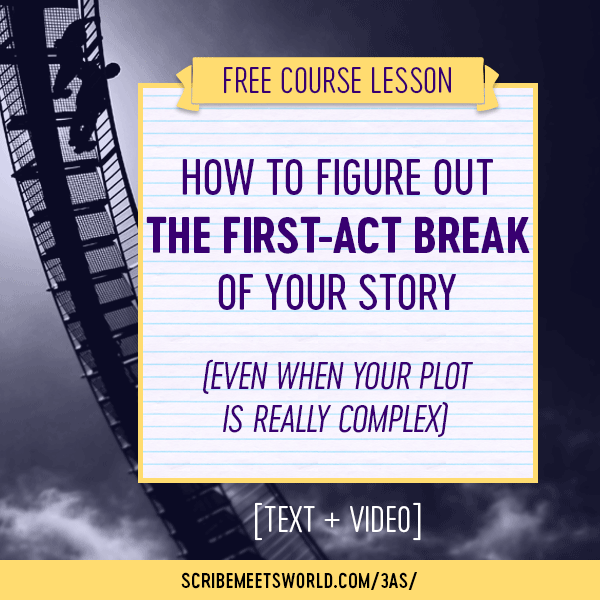
Building your script outline with three-act structure? Watch this (free) course lesson to learn how to break from Act One to Act Two.
Note: In the method I teach in my course, you’ll actually figure out your first-act break before the inciting incident. But for this article, I decided to arrange the steps according to the order that the eight essential plot points typically occur in a screenplay.
A tip to file away for future reference: amateur screenplays are notorious for elaborate first acts that are simply too long.
When you revise your script, double-check to see where your first-act break landed. It should occur somewhere between pages 25–30 (possibly even earlier, around page 18).
Step #4: Shake up the plot with the midpoint.
The midpoint, as its name implies, occurs at the middle of:
- your screenplay, as a whole
- Act Two, in specific
The midpoint changes the entire direction of your story.
For example, in a “good vs. evil” type of story, the good forces have experienced setback after setback. But at the midpoint, something happens that changes their fortunes for the better. For the first time, success seems like a possibility.
In a romance, comedy, or drama where people of different personalities are thrown together, the midpoint marks the moment where they stop seeing each other as enemies, usually by accomplishing an important goal together.
If you’d like eight ready-made options to choose from for your midpoint, check out Part II of my writing guide Sizzling Story Outlines. Or, for a deeper dive into each midpoint, take a look at Midpoint Magic.
Actually…would you like to learn about two (of the eight) midpoints right now? No problem. Click here (or on the image below) to preview Lesson 2.1 from my online course on story structure.
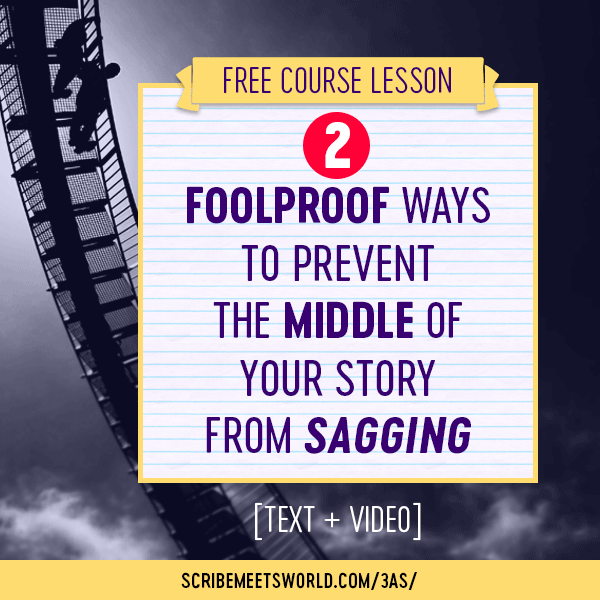
Need help coming up with a midpoint for your script outline? Watch this (free) course lesson to learn about two midpoints that are tried-and-true.
Step #5: Highlight your protagonist’s commitment with the fork in the road.
The fork in the road is where your main character reaffirms or escalates commitment to his goal.
Before we get to examples, I must confess I didn’t think much about this plot point until I read Viki King’s screenwriting guide How to Write a Movie in 21 Days. According to King, this point of commitment happens around page 60 of a screenplay.
At first I was skeptical, but then I started looking for it–and lo and behold!–it was there, just as she said…usually clocking in 60 minutes into the movie.
In a movie with a romance, the commitment might be literal, i.e. this could be when the hero proposes to the heroine. In Crazy Rich Asians, you can find an interesting variation of this.
Nick doesn’t propose to his girlfriend, Rachel. Instead, he declares his intention to do so (and shows off the fancy engagement ring he’s bought) to his best friend. Part of this scene is featured in the movie’s official trailer. Check it out below. (It’s cued to right before the fork-in-the-road clip.)
But you don’t have to take the idea of commitment so literally. Honestly, the fork in the road can play out in many different ways.
One of my favorites is when the protagonist has to choose between two ideals or character traits, like:
- career and love
- duty and love
- selfishness and sacrifice
Similar to opening and closing images, the fork in the road is one of the least essential plot points. The structure of your story will still be quite sound if you don’t come up with one now.
In fact, after you finish your screenplay draft, you might discover that you included a fork in the road in the middle of your story without consciously intending to do so.
That said, depending on the type you use, the fork in the road can lend a layer of sophistication to your plot. It’s definitely a plot point you want to have in your toolbox if you want to achieve the holy grail of screenwriting: a screenplay that’s plot-driven and character-driven.
If that’s something that interests you, you can find more details about the fork in the road in:
- chapters 5 and 6 in my writing guide Midpoint Magic
- Lesson 4.3 in my online course Smarter Story Structure
Step #6: Bring your protagonist to his knees at the “all is lost” moment.
At the “all is lost” moment, your protagonist experiences an extreme setback. He’s the furthest he can possibly be from his goal. It seems impossible for him to accomplish it.
This moment usually marks the end of Act Two.
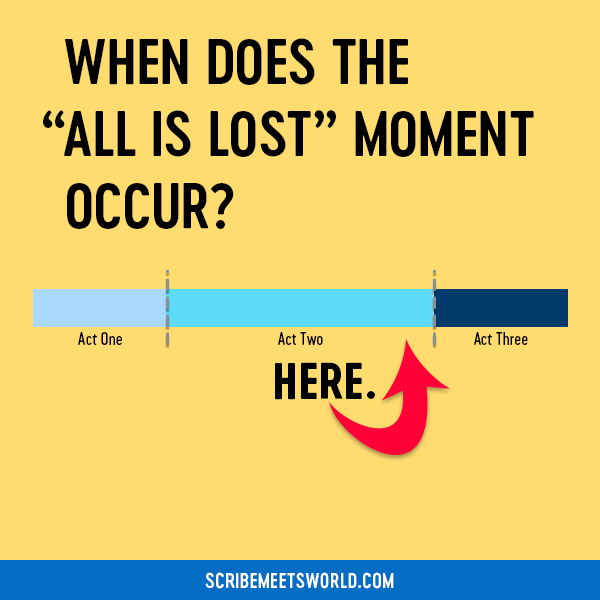
This is where the “all is lost” moment goes in a script outline.
A lot of writers struggle with this part of their script. They have no clue what to put here. If that sounds like you, below are some resources to help you out:
- This writing article describes the 3 keys to crafting the perfect “all is lost” moment.
- Page 12 of the Ultimate Story Structure Worksheet (which is free) will give you 7 options to choose for your “all is lost” moment.
- This writing guide is full of tips on how to make sure you end the middle of your story with maximum impact.
Step #7: Have your protagonist engage in his final attempt to achieve his goal at the climax.
At the climax of a screenplay, your main character will test his mettle against the antagonistic forces that have thwarted him from achieving his goal.
This is the final showdown between them. To emerge victorious, your protagonist must gather his resources (both internal and external).
If your protagonist has a tragic flaw, this is where he’ll demonstrate that he has overcome it. This is also where all the lessons he learned during Act Two will pay off.
The key to writing an amazing story climax is to prolong the tension for as long as possible. For tips on how to do that, click here.
Also, you want to make sure that you don’t resort to deus ex machina to give your protagonist victory at the end of the climax. Why? It’s a plot device that audiences loathe.
Naturally, the climactic showdown will vary according to genre. To illustrate the difference, I’ve posted two clips below.
The first is from the climax of the action fantasy Return of the King (the third film in the Lord of the Rings trilogy).
The second clip is from the climax of the romance Pride and Prejudice (the film adaptation starring Keira Knightley and Matthew Macfadyen).
By the way, if you’re struggling to avoid the “race to the airport” cliché that plagues the ending of so many rom-coms, you can find tips to overcome that in my writing guide Story Climax.
The setting can make or break your story climax. That’s why, as you put the finishing touches on your script outline, it’s worth it to spend a little time reflecting on where your climax will take place.
The setting of Mount Rushmore adds extra pizzazz to the climax of North by Northwest, as you can see from the clip below.
Step #8: Show what your protagonist’s life is like after his journey at the resolution.
Ah, you’re almost done with your outline!
Last step: to choose the resolution, the depiction of the final outcome of your protagonist’s journey.
Resolutions come in three types:
- happy
- tragic
- bittersweet
If your screenplay has a happy ending, the resolution is the best part for your main character. He gets to enjoy the fruits of his labor. His world is in balance again.
Below is a scene from the resolution of A Beautiful Mind. It is a happy ending that illustrates Nash has (a) conquered his mental illness, (b) reconciled with his wife, and (c) achieved recognition (after years of striving for it).
If your screenplay has, shall we say, a more European ending, the resolution will be either tragic or bittersweet. If tragic, he won’t accomplish his goal. If bittersweet, he might accomplish it—but at great cost.
If you want to make money, though, opt for a happy ending because happy endings are more commercial. For other considerations to reflect on to pick the perfect resolution for your story, read this.
And now you really are done. You have a loose outline for your screenplay that will help you save time as and after you write.
Can you stop here and dive into writing your draft? Or do you have to add more details to your outline?
The answer depends on your writing style and—equally important—where you are on your screenwriting journey.
More specifics in the next section.
Do You Have to Write a Script Outline…Or Can You Wing It?
Short answer: it depends.
If you’re just starting out (or if you’re only writing for yourself)…
You can use whatever process you like.
You can write out an entire draft to discover your story and what it’s really about. You can write on the fly, by the seat of your pants.
That said, if you decide to wing it 100%, then you won’t be able to enjoy the benefits (i.e. faster, easier writing) discussed earlier.
You can get a taste of those benefits, however, if you’re amenable to a compromise: you don’t have to figure out all the plot points in your screenplay—just its basic structure. To get help with that, download my (free) Ultimate Story Structure Worksheet.
If you’re not averse to outlining, then the real question is: What degree of detail should you go into in your script outline?
If your outline is for your eyes only, then that’s completely up to you. Keep in mind, there is a correlation between the volume of detail and the benefits you’ll enjoy.
The more detailed your outline, the more time you will save in the long run.
This is how screenwriters Robert Ben Garant & Thomas Lennon put it in Writing Movies for Fun and Profit:
The longer your outline is, the more problems you’ve worked out in advance and the less likely you’ll hit a wall while you’re writing the actual screenplay…if you have an outline, there should be NO WRITER’S BLOCK. You know exactly where you’re going and what the next scene is, and you never have to slow down (except to watch funny cat videos).
Their outlines run about 20 pages, by the way.
When you eventually become a working screenwriter in Hollywood…
The choice is out of your hands.
Decision-makers don’t have time to read full-length screenplay drafts. At the same time, they need something that will enable them to accurately assess the merits of the project.
Enter the script outline.
With it, they can gauge whether your story will fall apart, go off the rails, or stagnate—without having to invest time reading the whole script.
Which means that you need to cultivate the skill of writing a script outline at some point. Might as well start now, right?
As for the level of detail…that’s, likewise, out of your hands.
It’s entirely up to the studio executives.
Ask them what kind of length they’re looking for, and use that to gauge how detailed your outline should be.
If they say that your script outline would ideally be 3 pages (at the max)—and yours is 10 pages, then you know that you went into too much detail. You have to cut back.
If they say the ideal is 5 pages, and yours is 3 pages…well, as long as you hit the highlights, you might be able to keep things just as they are. For someone as pressed for time as a studio executive, shorter is generally better.
Going Further With Your Script Outline
If you need more help with outlining a script, follow one of the suggestions, below:
Download the Ultimate Story Structure Worksheet.
This worksheet contains questions and checklists designed to help you easily construct a script outline of your own. (Remember, you can use it to outline a novel, too.)
Best of all, it’s absolutely free! Instantly access the story structure worksheet here.
Read Sizzling Story Outlines.
Are you tired of getting stuck in the middle of writing?

It will give you more step-by-step instructions on how to make outlining work for you—whether you are a plotter or a pantser.
(Hint, hint: with the guidance in Part II, you will be able to crack the middle of your story without any problem.)
Sizzling Story Outlines is a must-read craft book if you want to:
- shape your idea for a screenplay or novel into a well-plotted story
- improve your ability to put together a story
- see further ahead in your plot or fill in missing gaps
- make outlining easier—and writing your draft more fun
Buy now, unleash the full power of outlining, and say good-bye to half-finished drafts (or half-finished outlines)!
Download the ebook instantly or buy the paperback (free shipping with Amazon Prime):
Amazon (US – ebook) | Amazon (US – paperback) | Amazon (international)
Download the ebook instantly from:
Apple | Kobo | Smashwords
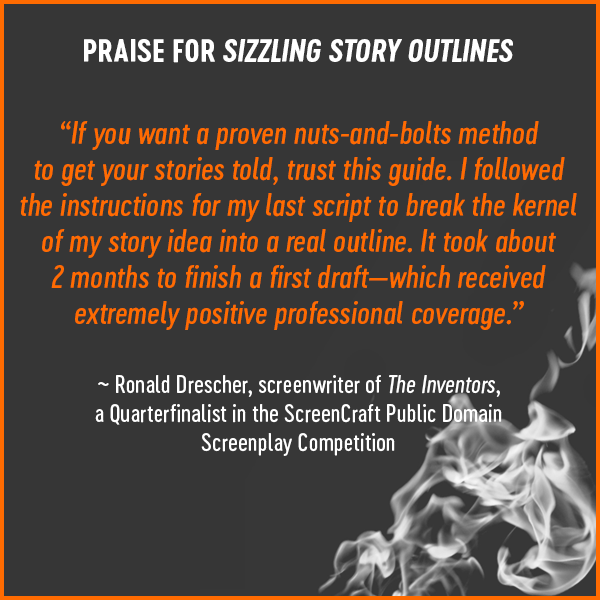
Enroll in my online course Smarter Story Structure.
Story structure is the key to creating the up-and-down rhythm that audiences find so addictive. This course is your shortcut to wielding story structure like a pro.

With this multimedia course, you’ll learn practical tips for overcoming plot problems like these in your screenplay or novel:
- the story starts too slowly (according to a Goodreads survey, 46.4% of readers abandon novels for this reason)
- the story doesn’t get going until halfway through (this happened in almost a quarter of scripts read by a studio reader in a year)
- the middle “runs out of gas” (even John Grisham admits this is a tricky issue)
- the climax doesn’t deliver fireworks, merely sparklers
- the story is the right length…but isn’t a good read (uh-oh)
Enroll today and learn (from the comfort of your own home!) how to use the essential plot points to give audiences a roller-coaster ride.
Script outline posted to a glass wall by Irfan Simsar




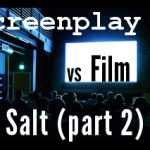
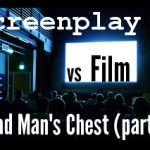















Comments on this entry are closed.
What nonsense !! How would you apply these rules to such landmark films as 2001, SOLARIS (tarkovski) or David Lynch’s LOST HIGHWAY ,,,
Dave,
I can understand your indignation. It seems like I’m trying to stuff the magic of a story into a segmented little box. But that’s not my intention at all.
First let me say that these are guidelines, not rules of the “thou shalt not kill” category.
Secondly, knowing these plot points in your screenplay makes it a lot easier to navigate 100-120 blank pages because you’ve got goals to write towards. They also prevent your screenplay from having an aimless plot, which drives most readers crazy.
The point of Scribe Meets World is to help aspiring screenwriters sell their screenplays (without sacrificing their artistic integrity). Since most produced movies and screenplays that have sold recently have these 8 plot points, it makes sense that a spec you’re hoping to sell would have them too. At the very least, you should be able to identify these points to studio executives because they LOVE them.
Now I haven’t seen 2001: A Space Odyssey or Solaris (to borrow from Joseph Conrad, “the horror, the horror,”) but I find it difficult to believe that movies which are such classics lack a climax or a resolution…
Both films, “2001: A Space Odyssey” AND “Solaris”, as they are both brilliantly and successfully plotted non-traditionally and more unlike your 8 plot-points, they both do have a climax and a resolution. In “2001: A Space Odyssey”, the climax is when the protagonist realizes he is suddenly locked out in space out of the mother ship, when the artificial intelligent robot machine that verbally controls the ship through voice commands will not let him re-enter the ship, electronically, so his resolution is to enter the mother ship through the only reliable means, his back-up manual entrance, against the robot’s verbal commands, which upsets the robot, and then he decides to shut down the computer robot system altogether, permanently, ultimately delivering the message that humans can never put complete trust into any computer machine to be in charge of their resources for survival, that only humans can be in charge of that manually. In “Solaris”, the climax occurs when everyone on the space ship, except for one, is plagued and had dies by the cosmic disease while stationed out in space over a billion miles away from Earth. The protagonist is one of the plagued, but he is still alive. The lone survivor decides to return to Earth and escape the cosmic disease. But the protagonist’s resolution is that instead of taking the option to go back to Earth with the lone survivor, he accepts to remain behind, as he has fallen in love with the physical manifestation of a beautiful human female that the cosmic airborne disease has created for him, which has removed him completely from his reality into a physically altered dimensional state of mind to live with her forever while trapped in outer space over a billion miles away from Earth, and that is where the film ends.
These brilliant 8 plot points are NOT nonsense AT ALL, Dave, you stupid ignorant half-brained moron! You don’t even know crap about how to even begin to write a successful movie script, so SHUT THE HELL UP!!! Only a complete jack-ass mindless idiot like YOU would come out and make such an irrationally preposterous and brainless juvenile comment like “What nonsense” to an obviously well-structured lay-out description of 8 plot-points for a movie script!!! You are obviously a complete pathetic ignorant with not the slightest rational sense of comprehension! Your brain cells cannot even process logical and rational information even clearly spelled out for you right in your face that you instead resort to react like mindless African savage baboon! The screenplay expert who posted these well-constructed 8 plot points NEVEr said anything about applying these plot points to every single film there is and has ever been made out there in world! The 8 plot points are a general structure of plots that is commonly applied to MOST films, not an exact blueprint to every single film ever, you idiot! You don’t even have to copy exactly every 8 plots as they are, as you can minus one or add an extra plot and makes certain changes in each plot structure, as well, which is how you get to write and create such amazing non-traditional films like “Solaris” and “The Lost Highway”! Use your head, at least what’s left of it, before you decide to say or post something so stupid and so ignorant like, “What nonsense!!” YOU are the one who is complete and utter nonsense and the load of absolute ridiculous brainless crap that comes out of your stupid ignorant mouth is what is total NONSENSE!!!
To the person who posted the original 8 points..it really opened my eyes. Ive been writing for years, mostly jibberish if u ask me, songs, comedy, lately the beginning of a script that I thought might make america laugh like we all need to some days..but I didnt know hiw to put it together. Thank you. Im clearer now. And no matter were it goes. Your knowledge was helpful and guiding. Never let someone like the negstive people who write on the bathroom walls ever chamge whats in side of you..they get what they need in your reply..thanks again
Hi Jason,
Thanks for your comment. This is the kind of feedback which keeps me motivated! I wish you the best of luck with your comedy script!
PS: You might find these posts to be helpful:
Comedy Writing Tips from the Hangover
Raunch-Free Script Tips from Bridesmaids
I absolutely love this blog. It is all I have been reading since I found it a couple of days ago.
Ignore Dave. He is one of those ‘artistic’ types who value style over substance.
I read one quote from this type that absolutely flawed me,
“Steven Spielberg is too audience driven to be a great director.”
It’s like saying,
“This hospital is too patient driven to be a great hospital.”
I am a newbie but it would seem to me that the audience should be you number one concern. Artistic types don’t seem intelligent enough to grasp that your blog is about great guidance, not set in stone rules.
I have read many of your posts and have then analyzed the screen plays I am currently working on. I am seeing a lot of mistakes that I didn’t notice before, thanks to your great blog.
Many many thanks Scribe 🙂
Hi Bruce!
I’m so glad that Scribe Meets World has helped you with your own screenplays! That’s what this website is all about.
Your observation, “audience should be your number one concern” is spot-on. If you write with this as your guiding principle and familiarize yourself with screenwriting basics, your spec scripts will be way ahead of the pack.
Your support is very much appreciated, and if there is a particular screenwriting issue you’d like to see addressed in a post, please let me know through the contact page or in the comments.
Good luck!
This article changed my whole outlook on screenwriting. Structure is exactly what I need to focus on! As an aspiring screenwriter, this website has helped me beyond belief.
Just wondering, have you ever heard of Script Frenzy? It’s a 30-day competition in April for screenwriters to write an 100 day script, and it is incredibly motivating. I did it four years ago, and I’ve been hooked ever since.
Hi Amy,
Thanks for visiting Scribe Meets World– I appreciate the kind feedback!
I have heard only positive things about Script Frenzy, although I have never participated. If you can dash out a script in 30 days, you have a great rough draft to work on in the following months. That’s often the hardest part, to write pages that you can work with and mold into something really great. I’m glad it’s helped you stay motivated!
I agree with Bruce. Films should be all about emotion. At least in my opinion. I put these plot points to the test and sure enough, they´re all in the blockbuster movies!
Hi Claraspeak,
Thanks for visiting Scribe Meets World! I’m glad you put these plot points “to the test.” While I like to think all the posts here are helpful, they are much more so when you actively engage with them and use to them to analyze movies and/or your script in progress.
One of the drawbacks of being a screenwriter is that you work so hard to cultivate an analytical eye so that you can assess your screenplay and fix its errors…that you often can’t just sit back, relax, and enjoy a movie. Depending on a movie and how eager I am to see it, I’ll make a conscious choice to turn my analytical mind off and try to just enjoy the movie for its own sake, at the least the first time around. If I think I can learn from it, I try to watch it a second time and look for clues to its success (or lack thereof).
Of course, this isn’t very efficient, but this way I get to be a satisfied movie-watcher and screenwriter all at the same time!
That does not make those blockbuster movies great just because they contain the 8 plot points. Limiting your screenplay story to just these 8 plot points makes your story become too predictable and reduces many possibilities of it becoming potentially innovative, unique, and original, which is one of the main goals to writing a good script. Too many of these blockbuster movies are too predictable and lack a great compelling story, because they depend too much on the 8 plot points by revolving the story around the plot points, instead of the other way around, making the story become bland, typical, weak, and boring. At the end of the movie, you go home feeling uncompelled, unemotional, unmoved, and unsatisfied, all because the screenplay paid more attention to mechanical structure than a compelling and artistically creative story, where most of its attention should have been.
“But would they want to spend an hour and a half of their lives watching him “SWILL” alcohol, do drugs, and “OOGLE” women?” Oh, I THINK YES!!! As a matter of fact, DEFINITELY YES!!! And you have to be quite a moron of a human being to actually think NOT!! “Oogle” women!? “Oogle”!?!? Ha ha ha!!! LMFAO!!! Yeah, interesting choice and interesting USE of a smarmy juvenile pseudo-terminology that you place such out of context here and one that does NOT exist in the English language.
First of all, whoever the mindless idiot who cooked up this preposterously irrational statement about Charlie Sheen, Charlie Sheen does NOT “oogle” women, you moron. That is your ridiculously idiotic and despicable sex-negative media-brainwashed juvenile fake term for pretentiously romancing and seducing women! Charlie Sheen does NOT “pretentiously” romance and seduce women! He realistically, honestly, and maturely, AND successfully romances and seduces women like a true intelligent educated right-minded and mature REAL man does in REAL life, so cut the crap with portraying the idea of romancing and seducing women into sex as some type of bad thing or something, because you sound like a complete brainless idiot, and nothing could EVER be further from the truth!
That’s what differentiates Charlie Sheen from other men. Charlie Sheen is a real man, unlike too many pathetic childish feeble-minded wimpy idiot guys out there, who are NOT real men, who, instead of properly seducing and romancing women the way they SHOULD be doing, biologically, instinctively, and intellectually, by Nature, the way all-out-success Charlie Sheen does, resort to surrender to the pathetic ideological perversions of abstinence, marriage, monogamy, commitment, exclusive on-on-one “missionary position” sex, and stomach-turning pseudo-moral crap, like the push-over pansies and cowards they are, right before their mentally sick and degenerate radical feminist sex-phobic delusional monogamist-crazed skank women who control them, which 8 out of 10 times always results in absolute misery, torment, suffering, and regret.
That is why Charlie Sheen is better than those push-over pansy coward loser guys and why he is a total success in his career AND in personal life, despite that whole media fabricated charade of nonsense that bullied around him in the news early last year, and YOU are so feeble-minded enough to get sucked in by the lies and the bull crap cooked up by the ignorant sex-negative media around Charlie Sheen, to have the nerve to write up that incredibly idiotic and very false statement you wrote up here against Sheen. But, you just keep sucking up to the bulls**t, right!?
“Swill”!?!? Ha ha ha!!! LMFAO again! Wow, you really are easily sucked in by the media-fabricated bulls**t! It’s incredible to see how some people are just so easily manipulated by publicized lies and exaggerated facts. For your information, just like charlie Sheen does NOT “oogle” women, He also does NOT “swill” alcohol! He DRINKS alcohol, just like any other normal sane right-minded person who drinks alcohol, and as far as doing drugs, so what!? He may do are may have done drugs just like any other person who has done who did NOT become addicted NOR sick from it.
Contrary to your irrational opinion, if the real Charlie Sheen were turned into a movie, realistically, people would WANT to see a good amount of Charlie seducing and romancing several women, many of them simultaneously, as the romancing and seduction of women by both men AND by other women are always one of the highest and greatest fail-proof natural selling ideas for movie plots that always succeed, and that is a fact, as well as they would want to see how he deals with the situation and dilemma of his career at that moment, but should the romancing and seduction of women end at some point in the film, the whole plot and story would be ruined and crumpled to pieces! The rest of the story wouldn’t matter much anymore, because he most compelling aspect of the character’s persona would be gone. The story would collapse, and the film would surely turn out into a total financial flop at the box office.
Who Charlie Sheen is as a character and as a real person, as a charming alpha ladies man who always romances and seduces many different women with power, charm, intelligence, and wit, almost always successfully leading to great passionate uncommitted and unrestrained meaningful sex, and who is financially wealthy and independent with a good solid career, is EXACTLY the character that people DO WANT to see in Charlie! Otherwise, his character and the story becomes uninteresting, unrealistic, and very boring, and it’s not Charlie! So, YOU got it ALL wrong to have the sick nerve to actually resort to the mindless thought that somehow people would actually NOT want to see Charlie Sheen being himself, being a real man. And as far as seeing Charlie “swill” alcohol, that’s another one of your media-fabricated out-of-context mindlessly stupid and ignorant terminologies of pointless negative judgment you are attempting to utilize again for no good reason.
The interesting part of the journey aspect of the plot would NOT be Charlie Sheen trying to make his way back to “Two And A Half Men”, because that may not be what he wanted. Maybe he did not want to go back to “Two And A Half Men”, and even if he did, his normal sane rational human behavior of drinking and seducing women, the way MOST people in the world do and the way ALL people should do, by naturally intelligent human biological fact, has absolutely nothing to do with his loss or his losing out from returning to the show.
As a matter of fact, it’s Charlie’s occasional excessive drinking and his dedicated passionate commitment to seducing and romancing women into passionate meaningful sex that made him the great celebrated and loved character that everybody wanted to see, his seductive passionate sex with several different women he recently met being far more meaningful than the ever-so-tragic meaningless committed monogamous love-based sex his brother Allen had, the little he ever got throughout several years, with his then psychologically neurotic sex-negative crazy feminist bitch ex-wife, Judith, and all that is which made a large part of keeping the show together for almost 10 years.
Actually, a better plot to the life of the real Charlie Sheen would be if at some point he gives up pursuing his return to “Two And A Half Men”, because he realizes it’s not worth it anymore, but the drinking, the doing occasional drugs, and especially the romancing of women part of his character always stays intact, because THAT is what people WANT to see, not just in Charlie Sheen but in many male AND female lead protagonist characters, so cut the ridiculous childish nonsense with making the beauty of drinking and seducing women out to be a bad thing, in some strange bizarre way if even possible, by using stupid smarmy pretentious terms that are completely out-of-context and juvenile such as “swill” and “oogle”, because you sound like some sick religiously perverted sex-negative sycophantic feminist-supporting pseudo-moral-crazed degenerate. Drinking alcohol, getting drunk, and romancing and seducing women into sex are ALWAYS a good thing, and THAT is an unequivocal and an inarguable fact!
Too long, did not read
And BTW, romancing and seducing lots of different women on a regular basis every week non-stop or as often as one needs and desires is NOT an addiction, not by any means, whatsoever, and never does it EVER become an addiction! So, do NOT ever place the constant glorious sexual pursuit of many different women into the same category as the constant pursuit of drugs and alcohol, like some despicable sex-negative jerk, because sexually pursuing after women constantly is clearly NOT the same as constantly pursuing after drugs or alcohol! What are you some kind of sick disgusting sex-phobic misogynist religiously perverted creep!? Apparently, you think you can come out here on public internet and self-appoint yourself as some type of elect who gets to dictate how much sex and how many women people can have sex with, including when is too many women and too much sex!?!? You’re kidding, right!?
The constant sexual pursuit of women is NEVER an addiction, because the constant sexual pursuit of women is how humans survive, not just biologically, but how we survive, emotionally and psychologically, as the normal healthy functional and very rational behavior of sexually pursuing women constantly is a biological human necessity that comes directly from Nature, NOT to procreate, but to achieve the constant sexual gratification that the human body needs on a regular basis in order to alleviate the testosterone and estrogen levels that help people become physically and psychologically stable enough so they can actually carry on with the world, and that balance can only be achieved with true equilibrium by having lots of sex with lots of different and new partners on a regular basis, always constantly searching for new partners when necessary!
There is NEVER a limit to how many different women one can have sex with, and however many different women you have sex with never becomes an addiction! That type of despicable way of thinking, where the constant sexual pursuit of many different women is somehow an addiction, is an ideological perversion and an imposed mental corruption. You do NOT put women into the same category as drugs and alcohol! Women are NOT a bunch of things labeled like shelf items NOR are they things that cary the same kind of potential risks and hazards as man-made products do, like you so disgustingly implied with your perversely stated corrupt ideology that Charlie Sheen should overcome his “addiction” to drugs, alcohol, and to “women”!
Women are NOT something you grow an addiction for! They are beautiful sexually enticing intellectual actual human beings who give birth to other humans of both sexes, who are the only reason you even exist, and whom we all, both men and other women, become emotionally and sexually aroused and passionate for to endless levels of needs and desires without limit! There is NO becoming addicted and there is NO “too much” when it comes to the sexual passion for women, and you do NOT get to dictate any conditions NOR terms on women, on our sexual desires and pursuits for women, and how we go about them, EVER, you despicable sex-negative creep, so get that ignorant religiously perverted and destructively corrupt ideology of “too many women equals addiction” misogynist judgmental bigoted stupidity and sack of bulls**t lies out of your sick head!
Too much drugs can lead to sickness and death. Too much alcohol drinking can lead to poisoning and death. Having sex with lots of different women does NOT lead to physical sickness NOR death, so having sex with lots of different women on a regular basis in constant pursuit is NEVER a problem NOR does it ever become an addiction, and neither you NOR anyone EVER gets to dictate how much sex and how many women one can have sex with!
As a matter of fact, people become physically sick and very mentally unstable when they are NOT having much sex or not having ANY sex at all! People also become physically sick and very mentally unstable when they are having very non-gratifying and miserable sex, usually one on a very steady decline, usually within a marriage, with one single partner and being psychologically trapped with and becoming less sexually attracted to as the years go by.
There is absolutely NO NEED for Charlie Sheen to stop sexually pursuing many different women, just as there is no need for ANYONE in the world to stop sexually pursuing many different women on a regular basis, whether you are a man or another woman, because always having sex with many different women on a regular basis is NOT a problem! It is the necessary biological manner in which we survive and live functionally, and it is always a good thing! You have to be religiously perverted and sick in the head brainwashed with such despicable moral crap to have the nerve to ideologically portray the natural sexual pursuit of many different women as if to be an addiction or some type of unhealthy behavior, when nothing could be further from the truth.
That being rightfully and factually stated, here is the real true rational question. Would movie viewers want to spend an hour and a half of their lives watching Charlie Sheen “swill” 12-step brainwashing ideological lies and bulls**t barfed out by so-called “experts” during supposed detoxication programs, watch him swill the same irrational and brainwashing despicable lies and bulls**t, such as the cooked up fabricated concept of “love over sex” and other ridiculously perverse lies and nonsense by the same degenerate manipulators who will try to convince him of the bigger lie that he is somehow some type of sex addict, then have the viewers later watch Charlie “oogle” some religiously corrupt sexually repressed pietist girl, one single girl, into the perverted bowels of abstinence, commitment, marriage, monogamy, and exclusive heterosexual one-on-one “missionary position” sex, until they both drown into the priggish gutters of their own misery!?
Do you actually think viewers are going to want to spend an hour and a half of their lives watching this!?!? Oh, I think DEFINITELY NOT!!!
And all for the random sake to just see if he can “pull it off”!? Pull WHAT off!?!? A stop to his drinking and his rational behavior and devoted pursuit of sexual passion after women, just so he can transform into a sexually deprived and psychiatrically miserable wreck!? MOST DEFINITELY NOT!!! That is something that is NOT EVER necessary for ANYONE to have to pull off!
James,
In response to your comments:
Oogle and swill are descriptive verbs with “punch.” That’s why I used them.
I agree, you don’t want to write a movie whose plot revolves around the 8 essential plot points. Your script shouldn’t be mechanical drivel–but you don’t want to write an unorganized mess either. If you utilize the plot points correctly, each scene will flow organically into the next one so that nothing comes across as forced.
“Heart” is also a script essential. If the audience doesn’t care about the characters in your script, then they won’t give two figs that your screenplay is perfectly structured.
I think that a movie focused on Charlie Sheen’s exploits (with alcohol and with women) would be one-note. People would quickly tire of watching such repetition (I’m referring to full-length scripts, not to a 20 minute sitcom). I think audiences prefer to see progress, to see characters changing into someone better (or worse) than they were at the beginning of a film.
But that’s my opinion and assessment of audience tastes. You’re certainly entitled to your own. You clearly have a lot of passion and a love for movies. Use this passion and write a screenplay–maybe about a character like Sheen or a “religious degenerate”–and see if any of the advice here is helpful, Charlie Sheen commentary aside.
Surprised you responded to James at all.
So am I. Run on sentences and BS – I couldn’t even read his whole diatribe.
You call him “James”, I’d be more inclined to call him “Charlie Sheen”. Charlie Sheen really loves Charlie Sheen, apparently. Yikes.
You seem like a super cool dude. or dudette. either way, props to how you handled this james douchebag.
Hi Austin,
Thanks for visiting Scribe Meets World! James’s comments have generated a lot of commentary…which I definitely like. Free speech is usually a win-win all around. For the record, I’m a dudette 🙂
Thank you for the excellent tips. I got here from story charts.ca, where I was motivated to go Googling for “Inciting Incident”. I’m very happy that Google put me here.
For what it’s worth, I find that a certain amount of pruning in comments can greatly improve the health of a website.
Hi Haakon,
Thanks for visiting Scribe Meets World! I’m glad you’ve found the site to be useful. I’ve checked out http://www.storycharts.ca — thanks for bringing it to my attention.
To further your study of screenwriting, I also highly recommend Scriptshadow (to learn more about the craft by analyzing real screenplays) and Deadline Hollywood (to learn more about the industry). Alex Epstein’s Crafty Screenwriting is also a real gem!
Pruning comments is certainly something to consider, especially as the site grows, but for now I’m letting the First Amendment reign!
After visiting your own website which definitely has a political slant, I wonder, have you seen the Ides of March? If so, what was your take?
Pruning and focus is welcome here, just like one expects from great screenplays which say more with less if great skill is involved.
AGREED re: pruning.
The giant post seems indulgent and perhaps obsessive. The visual tests for screenplay skill (brevity, clarity, discipline, consistency) apply here too. Ranting is NOT writing. Nor is free expression AUTOMATICALLY of quality and depth.
No! Don’t prune the website comments! That might mean I would never have got to read James’ epic response!
Although, at first, I thought the guy sounded like a complete idiot (it never does anyone any favours to launch into a needless personal attack on someone they have never met) as I read, I was surprised to find he had some very intelligent points to make. I had never really thought of holding the likes of Charlie Sheen up as an Alpha Male hero, who goes against our learned social constraints and, far from being immature in his pursuit of sex with many different women, is actually being true to his biological nature. I had never thought of married men as actually weak for turning their back against theirs. Once I had deciphered his special style of writing, I have to say I agree with much of what he wrote – except the manner in which he delivered it.
I think in a perverse way, it kind of highlights the key message of the site about the need for structure, lean writing and sticking to the key points. Great ideas, great content, can be lost when presented in a poor form. Good form is crucial.
Hi Hannah,
Thanks for visiting Scribe Meets World! I’m glad you enjoyed reading James’s comments…you’re right. When you view them from an evolutionary biology perspective, they do make sense. Or at least more sense.
Good form is absolutely critical. The organization of your screenplay is as important as its contents. If you have any movies that you’d like to see analyzed on the site, please say so!
Hi,
Thank you so much for this site! I’ve gotten a lot out of reading it as I tackle improving my feature comedy script. As I’ve been trying to see the 8 plot points in my own film I keep coming up with a few questions:
1. You wrote that at #6 the character has a re-commitment to his goal. And I was wondering why here? Why would someone right after the midpoint suddenly reaffirm themselves?
2. At the act 2 break”All is lost” and then the next moment after the break is the Climax: I keep wondering, doesn’t there need to be an additional plot point that is very important in between? How can someone go from losing everything to suddenly having what he needs to succeed during the crisis/climax.
I would be so grateful if you could help! This script might kill me.
Thanks,
Brooke
Hi Brooke,
Thanks for visiting Scribe Meets World! I’m glad it’s been helping you as your complete your comedy script.
Plot Point #6, the point of commitment, is something that I first came across when reading Vicki King’s How to Write a Movie in 21 Days. And after reading about it, I started noticing it in more and more movies–but it’s by no means something essential like a strong midpoint or climax. So if it’s causing you sleepless nights, I wouldn’t worry about it.
As to why it would come after the midpoint–a lot of times, the midpoint of a script takes the second act into a whole new direction. So it actually makes sense for the character to reaffirm his commitment to achieving his goal after the midpoint has shaken everything up. Also, it’s not like the character says right out, “I’m going to do this, and come hell or high water, nothing’s going to stop me.” But he SHOWS it.
The point of commitment might be a test to determine whether or not the character will continue on his journey–maybe it’s a temptation of sorts. At this point, it’s like the character has an “easy way out,” and usually, he’ll choose to stay “in.” You can see why the point of commitment is usually built into a lot of screenplays, because it’s a natural extension of the obstacle/goal/obstacle/goal sequence which is the backbone of plot. It’s just one in a series of obstacles, and by overcoming it, the hero shows his commitment to achieving his goal.
RE: the climax…yes, there are additional scenes between the all is lost moment and the climax. The essential plot points are like a checklist to follow to make sure that your screenplay has a solid structure. You’ll fill in the scenes between each one. The plot points make it easier to do so, because it makes your goal more manageable– i.e., okay, I just have to figure out what happens between the first act break and the midpoint…instead of, “ohmigod, I have an entire Act Two to write and I have no idea how to fill all those pages!”
Between the all is lost moment and the climax, something happens to make the hero rally and not give up on his goal. A lot of times, one of the supporting characters helps the hero experience a realization that he shouldn’t give up (like in Bridesmaids, Megan slaps Annie and tells her that Annie can’t give up when life has knocked Annie down). Then the character prepares for the final climax.
Going back to Bridesmaids, Annie prepares by getting her taillights fixed, baking a cake for Officer Rhodes, and by resolving things with Helen. Bridesmaids is about internal character transformation, so the climax isn’t a face off between good and evil (like a typical action movie or thriller), but about Annie coming to terms with her poor self-esteem. By seeking out Officer Rhodes and making up with Lillian, Annie demonstrates she’s overcome her internal demons.
I hope this helps–good luck with your comedy script!
Sorry for spam but just reading through the site – thank you scribe. Good words.
And Charlie Sheen 3D? Uber.
James is either Charlie Sheen or one of his personal friends.
LOL, Diana!
I think I should set up a separate section just for comments on James’s ramblings!
haha, James, u mad bro? Charlie Sheen’s #1 fan…
Great site, just found it!
Hi Gibs,
Thanks for visiting Scribe Meets World. I’m glad to have Charlie Sheen’s #1 fan as a reader. Winning!
Hi,
I’m relatively new to this site. But since finding it I have been on it non-stop! So thank you for all the helpful information. Now to why I’m here and my question. I am a writer slash film maker. Recently I was approached by a major holly wood producer about my work. So he now has one of my scripts. He likes it but said it was too “dense”. This eludes to what you have been saying about amateur scripts being too complicated and convoluted in the first act. I have read over the eight plot points; which was a big one with him. As again you stated that they are with Major Studio types. And I’m not really that far off. I feel with a bit of “sloughing” and a minor revamp I should be well to good. But my question is. do these eight plot points have to stay in this order?… I’m mostly referring to #6 All is Lost Can they be shuffled a bit? I’m not opposed to revamping this script. I’ve never been a “It’s my work and my baby” type of writer.
Hi Jeurgen,
Congratulations on getting a producer interested in your work! That’s a huge step–I hope you celebrated in style 🙂
In traditional three-act structure, the all is lost moment has to occur before the climax and the resolution. It can’t occur any sooner either because the protagonist has spent the entire second act preparing for that moment, but instead of claiming victory, he suffers defeat.
He’s the absolutely farthest from his goal, despite everything he’s done in the second act. Only by gaining new insight can he rally his strength for one last attempt in the climax. If your script has a happy ending, then he’ll also gain pretty much complete victory at the resolution.
So I guess the short answer is no–you can’t really shuffle it around. I’ve never been a believer in fixed page numbers, so it’s not like you have to have the all is lost moment on a specific page, but chronologically, it has to come before your climax and resolution.
First acts are hard to trim, usually because the writer is so focused on giving the audience background information. If the characters are interesting and the protagonist has a compelling goal, the audience will still follow along…even if they don’t have all the background info. Give them some credit–if they’re hooked, they can wait till act two for more details/explanations. Is there a character introduction you can delay till Act Two instead of including it in the first act? That might be one way to trim it down.
Density can also refer to how “lean” your writing is. Using fragments and fewer words will make your script feel lighter. Make sure none of your paragraphs are longer than four lines–and minimize overly long dialogues. But take this advice with a grain of salt. You don’t want to ruin the voice which hooked the producer in the first place!
Good luck!
Thank you SO much! Now that mu thoughts have had more time to “congele” so to speak. Im pretty sure I’ve got it down. 🙂 thanks again. And your sight is awsome by the way.
Dear sir,
I want to prepare a story outline for a suspense film based on college student’s life.
Would u kindly help me in this matter.
I will be highly oblised if it could be possoble
Hi Nagesh,
I can’t give you specific help regarding your project, but I am planning to write a post which describes how to plot your movie from beginning to end. I think this will be helpful for you, and I’ll let you know as soon as it’s completed.
In the meantime, you might want to read Alex Epstein’s Crafty Screenwriting or Blake Snyder’s Save The Cat, as they both give helpful advice on this topic. Also, study the plot points for as many suspense movies as you can find. Taken isn’t a bad place to start!
Carson Reeves over at Scriptshadow has done several reviews of thriller scripts. If you go through these, you can learn a lot, not just from the post itself but also from the comments. Good luck!
Having just been getting my first invitation from a famous Hollywood director to write an outline for a story I suggested to him, I found this information very useful and it will come quite in handy when getting on to my first ever screenplay. Thanks for sharing great tips, looking forward to stepping into the moviemaking world!
EA,
What exciting news! I’m so happy for you and glad that this post gave you some helpful guidelines. Keep in mind this article only describes the essential plot points; you’ll probably need more to flesh out your story outline. Hal Ackerman’s Write Screenplays That Sell will come in handy at this stage.
Good luck!
Thank you, thank you,for this. Plot points have set me straight. I have written them down and the journey begins…I do have a European Ending, but I hope it is strong enough to touch the audience as It touches me. Are there any examples of death being a better place? It is not morbid by any means, but it is symbolic to the resolution. My character is happy to meet his lost love once again. Any thoughts?
Hi LovePearls,
I’m glad this article helped you! Off the top of my head, Gladiator (which seems especially pertinent for your project) and Braveheart are both movies where the death of the protagonist made for an extremely strong ending. I don’t think anyone in the audience was complaining! If I think of others, I will post them here.
Good luck with your script!
Smoke meth much james?
Anyways, so I see how these main points relate around a story where the hero is put into a predicament, has a series of setbacks, one setback is above all else, the worst. At this point something changes (I think we can all agree this is very resonating.) And in the end the hero triumphs.
So my question to you is… what happens if in our story there is a sense of hopelessness and the hero never suceeds and the light at the end of the tunnel never gets larger? Could the story be appealing if there is a climax but not a summit by the hero?
Hi Greg,
You always have to do what’s right for YOUR story. That being said, here are three thoughts to consider:
1) Real life can be hopeless enough. People go to the movies in part to escape that feeling. You might want to reconsider a completely bleak ending–just for marketability’s sake. If your hero fails, the possibility of a hopeful ending should exist for another character (however minor).
To quote Syd Field from his book Screenplay, “I once taught a workshop in Germany for some 50 writers, and out of 50 stories, 46 of them ended in death, suicide, mayhem, and destruction. I told the students that there are better ways to end a screenplay than to have your character caught, shot, captured, die, commit suicide, or be killed.”
2) Of course, a bleak ending may be exactly your point. The ending of Chinatown sure is negative–but that’s the whole point of the movie. The rich can–and do–get away with murder. If you can convey your point of view as well as Chinatown did, your script can be a calling card which can get you an agent and possibly assignment work–even if it’s not marketable enough to be produced.
3) People become immune to things the more they are exposed to them. For example, after awhile, if an action movie doesn’t pace its action scenes, audiences will stop feeling an adrenaline rush while watching them on-screen because they’ve become habituated to them. The same principle applies to a movie which leans towards the bleak side. If the hopelessness isn’t punctuated by happier, more hopeful moments, the bleakness will lose its effect and your audience will be numb to it.
In other words, there should be some success achieved at some point, otherwise the series of failures loses its impact. Two ideal points for creating a false sense of hope are a) at the end of Act Two and b) in the middle of your climax.
I hope this helps. Good luck!
I really have to thank you for this amazing site! I come from germany so it’s kind of depressing searching for really good german sites that might help you with your screenwriting process. I’m glad i found sites like your’s which have been very helpful!
This article really inspired me and also helped me a lot. But I still got a few questions and hope you can help me!
I’m still in kind of a learning process when it comes to screenwriting, but I’m working passionately on a screenplay at the moment and I’ve already outlined every major plot point so I know what the story is about and what my lead character really wants etc. I also outlined the eight sequences of the screenplay. So my next step is to start writing a treatment. I’ve already done this before and I think it is quite helpful so I totally agreed with your article about treatment’s I’ve read earlier.
But I was wondering how much outlining is too much.
While searching for outline examples I found a development for a screenplay of a TV show. It was just for one episode so it wasn’t the whole story of the whole season of this show. But what really confused me was that every single scene was outlined and written as kind of a treatment. But there’s other sites where I’ve read things like “When it comes to screenwriting, just outline at least your major plot points and then get it done”. Well, I thought maybe it is a good way to outline the whole script so you’ll know what you actually want to write about. But then I thought if I outline every single scene I want to write in the actual script, I will spend more time outlining than actually writing the script.
So it kind of confused me a bit and I wanted to know how you yourself handle those outlining process. Because, I think it’s good knowing where your story goes and having the whole plot structured in those plot points, but like you said in another article about the 80-20 rule, the more you research the less you write, I thought maybe it’s the same thing with outlining. Maybe I wont get the script done if I spend too much time outlining.
Hope you at least know what my problem is and can help me a bit so I won’t be as confused as I am right now! 🙂
Hi Julia,
I’m so glad that my site has been helpful for you! In regards to outlining, I think it is an essential part of the process. I like to outline as much as possible because I find that this reduces the amount of extensive rewriting I have to do later. You do raise a good point though–you can outline too much and never start writing your screenplay in the first place. This defeats the whole purpose of outlining!
This is how I approach outlining: first, I focus on cracking the 8 essential plot points. Then, I figure out what needs to happen in order for those plot points to occur. I add in scenes to heighten the emotion or to improve the logic, etc. This usually yields a list of about 40 plot points or so. I put each plot point on an index card and shuffle them around until I think I have them organized into a solid structure. Then I think about each plot point–how it should begin, what should happen in the middle, and how it should end. If any funny ideas or lines of dialogue come to me, I write these down as well. I don’t write much; maybe one side of an index card, sometimes both sides. It depends on how extensive I think the scene will be. I do this until I have filled out each index card…and then I repeat the process a couple of times.
By this point, I’m itching to begin writing! I think that’s a good indicator of when you should switch from outlining to writing. You don’t have to add details to the index cards, but I wouldn’t start writing before I had a list of all the plot points organized in a way which best tells my story.
This is, of course, the method which works for me. Some people hate outlining and write “by the seat of their pants.” It sounds though like you are an outliner like me!
To clarify, in the article about the 80-20 rule, I concluded 20% of your research will yield about 80% of the details you actually use or need. So I resolved to research less. By research, I meant time spent looking up factual details, not outlining. In fact, in the same article, I concluded you should spend more time outlining rather than less! (But not to the point where outline becomes a procrastination device.)
I hope this helps. Let me know if you have more questions!
I’m new to this site, but the ideas you post are timeless. Thank you for sharing your thoughts with the world. I especially found your Back to the Future notes very helpful. As for “James” earlier in this thread, I’ve found there are two types of screenwriters: 1) those who recognize that there indeed is structure to all great films and 2) those who think everything they write is flawless and if people don’t understand it or like it, they become pissed off and blame the world for their shortcomings. (And by the way, using 2001 and Solaris as examples only made your point stronger. Those movies never see the light of day without Kubrick or Clooney. Who was James kidding?)
Hi GBlivins,
Thanks for the kind words! I think once you realize how much time a solid structure and an outline will save you during the rewriting stage, you find these tools to be rather liberating than restrictive.
Can you imagine writing a film like Back to the Future without any kind of structural aid? Nightmare!
I’ll admit I pretty much hate outlining, but it makes the task of completing a screenplay much less daunting – and something that’s actually doable.
I find your website very helpful as I daily pursue my dreams of becoming a Hollywood filmmaker – so thank you!!
I just wanted to drop a note to say how much I am loving your advice! You offer up some great, concise tips for aspiring screenwriters. I am bookmarking your site right now. Thanks!
Hi Jill,
Thanks for taking the time to write a comment! Your kind words mean a lot to me. Good luck with all of your writing endeavors.
Hello,
I’m also an aspiring screenwriter, and I just started at about this time last year. So far, I’ve completed four movie spec scripts, one TV pilot script (an hourlong drama) and I’m currently working on a sitcom.
I think this list is a GREAT help. Anyone who has done anything knows that you ALWAYS want to start off with direction, especially if you’re new to it. To just “wing it” is almost never a good idea. Just like many others, I understand that these are just some good guidelines to begin with and of course, the better we get, the more we may be able to deviate appropriately. Some folks turn something like this into an English project and that’s why it drives them crazy, but what they need to understand is that this is just so you can have some structure and know where to begin. This also allows you to break the script down and focus more on doing maybe 30 pages at a time rather than trying to figure all 120 out in one sitting or get to one spot and just be stuck because you have no idea where to go next.
Obviously, with more experience, again, you’re better equipped to deviate, and that’s another thing a lot of folks misunderstand. We as amateurs are not in a good position to deviate just yet. We often want to compare ourselves to seasoned screenwriters and that’s not a good idea. All we see is the finished product and if it doesn’t match closely with this format or similar, then we wrongly think that no structure was used at all.
While I’ll admit that it IS frustrating to sometimes see work out there that looks like it stayed FAR away from this and is sometimes just plain bad, the thing for us to remember is that we DON’T want to be remembered for that. In other words, it’s easy to see that it looks like someone was able to put a halfhearted effort into something, succeed and then figure that that’s all we need to do as well. We want to make OUR OWN names.
Sorry to get into all that, but I just wanted to thank you for creating this list. As I said above, I’m working on a sitcom pilot now and I came online to look up good ways to outline that. I came across this, and I’m glad I did!
Hi Robert,
Thanks for taking the time to share your observations. You’ve summarized the benefits of outlining quite nicely. Outlines definitely make writing a longer work more manageable…and save you a lot of grief in the long run.
It’s interesting to read article by authors who don’t like outlining, but tried to embrace it (for whatever reason). For the most part, they end up concluding that outlining in advance saved them a lot of time during the rewrite process…
You’ve been enormously productive in the last year. It sounds like you’d be a great asset to a show’s writing staff.
From what I’ve read, the structure of a TV show shares similar principles to the structure for a full-length feature screenplay, but it does have its own nuances. (So you’d have to adapt the outline presented in this article.)
For more specifics, read Successful Television Writing by Lee Goldberg & William Rabkin and Writing the TV Pilot by William Rabkin (if you haven’t already!).
Best of luck 🙂
Great stuff!
Was looking to procrastinate from continuing with my outline so it’s always reassuring to know I’m not lost but on the right path. Inspired to get back to it!
Hi Amy,
Thanks for visiting Scribe Meets World. I’m glad to hear that this article inspired you to “get back to it!”
Good luck with your outline 🙂
I have a question.
So I’ve been trying to get at least a basic outline based on the worksheet you guys have, but I’m confused on what to do if you hero/protagonist’s main goal goes against everything your story is about.
For example: Say, your protagonist has an ability that can help people but hates it. So their main goal is to become ‘normal’ and ‘safe’. Yet there are all these conflicts that lead your main character to do the opposite on their goal–which I’m guessing is embracing their situation and ability.
If it’s like so, doesn’t that mean there are no stakes if don’t succeed their main goal? Or does it mean their main goal has changed??
I’m really confused….
Hi Bianca,
I haven’t seen it in a long time, but it seems to me that the plot of Spider-Man 2 matches the situation you’ve described. Peter Parker wants to reject being Spider-Man and embrace a “normal, safe” life, but, by the end, learns to embrace his superhero identity. Studying that movie should help you a lot.
Oddly enough, studying a movie like About a Boy may help you too because the “push-pull” struggle of the hero is similar, even though he’s not in possession of super powers.
To be more specific, Will (Hugh Grant’s character) professes an earnest desire to live alone, “like an island.” This is the equivalent of a protagonist who wants to be safe and normal. But Marcus won’t let Will alone; he forces Will to change and embrace life “like an island chain.”
I hope this helps. Good luck!
Thanks a lot. I believe an outline is to a scriptwriter what a business plan is to an entrepreneur. Your 8 plot points are a great breakdown of the classical 3 act structure and you have made my work very easy. Anyone who visits this site is blessed with some form of creative power, and as we all know, power is nothing without control. The control is in outline. I hope you don’t mind me mentioning you in my success story in a few years to come.
Thanks Derek for the kind words!
With your positive attitude, I’m sure success will come to you soon 🙂
I just found it funny: As I watch Into the Wild by Sean Penn (2007) to write an analysis paper- I noticed that the movie practically follows this plot point outline almost exactly. After reading this I am much more confident in analyzing the significance of the plot points to the story. Thanks!
Hi Marquise,
Thanks for visiting Scribe Meets World!
It looks like your first visit is an example of what Julia Cameron calls synchronicity.
I don’t know how to start writing a screenplay I have a lot of images in my mind it comes as dreams at time thought at time vision I need help
Wow, this post was so helpful! I’m actually looking for ways to write an effective outline for a comic I want to start, and most of my stories tend to lack structure. This list is a great platform to start building my own story on, and toScribe I can only say thank you!!! : )
Hi Sarah,
I’m so glad this article might help you with your comic–very, very cool…and perhaps a first for Scribe Meets World!
Hey Scribe!
Great website. I am recent Directing/Screenwriting graduate of a very hands-on industry-like film school. Being out of school for a while, my writing skills have been slowly dulling out. Planning to go to graduate school this fall for film, I decided I needed to reteach myself many things I have forgotten. Im film school, we talked about story, how we need a beginning, middle and end. We never went in depth to plot points, 3 act structure, lowest low, etc.. when my thesis advisor analyzed my thesis script he gave back feedback with words like, “the climax, things come in 3, lowest low…etc.” I did not really understand what he meant until after reading this (and many of your other links on your website). I was more of a directing major that took some writing courses. First of all I want to thank you for posting so often – please keep up! You have a lot of fans.
Two, in class, we mainly watched movies and then we would analyze them. We would talk about why it worked – the images (i.e. opening and closing images, how the movie made us care about the main character, etc…) It was more film, less theory. I’m not sure if you would consider your writing theory – since you said this website is for people who want to SELL their script. I went to a more art driven school; but my teacher tried to instill some business mentality as well. I would like to ask you, do you think as a writer who writes from the heart (usually) but also values a movie that has great structure (with suspense); do you think it’s better to first go with what you feel, then tweak it out? Or should I follow the 8 plot point structure, make sure it hits every point, then try to artfully craft it out?
Anyways, thanks again and looking forward to reading more! Would love to hear about some foreign films as well. I am working on a story that takes place in China, most of the characters speak Chinese. But the main is an english speaker; I am almost confused on who I should put the focus on audience wise. I guess that may be a question I have to ask myself!
And lastly, can you please do an analyzation on a Woody Allen film? I would like to see how he hits these 8 marks, or how he makes it work. He always has the most “taboo” relationships, yet it always works so wonderfully!
Thanks again!!
Hi Stacy,
It’s always best to write from the heart.
The key, though, is to figure out what kind of process works best for you. Some writers can plot in advance, while still writing from the heart; others feel that that they need more spontaneity (eg “pantsers” who write from the seat of their pants).
Choose the process that you enjoy most. Then evaluate your raw material and figure out how to mold it into the strongest story possible. (And most commercially viable too, if that’s your goal.)
If you’re a plotter, you’ll be working with an outline; if you’re a pantser then your raw material will be your rough draft. So, you always have to do some kind of analysis. But the point in time when you do that analysis depends on what works best for you.
Re: Woody Allen–his name makes his movies commercially viable. So an analysis of his films is unlikely to pop up on this site because basically only Woody Allen can sell a Woody Allen-esque movie. If you’re interested, Billy Mernit has an excellent analysis of ANNIE HALL in his book, Writing the Romantic Comedy. (The book is a great resource, BTW!)
Good luck!
I just want to say thank you for give us this information for FREE. In this world where people are just out to get the almighty dollar, it is so refreshing to see someone who obviously wants to help the writer. If I could show you my bookcase of a zillion books on screenwriting you would have a headache. You’ve managed to do what those books have failed to do for me for years. Coming up with story ideas and big concepts were never the problem for me. Structure on the other hand- ughh! Now I finally feel like I can approach structure the right way. When I win my Oscar for best screenplay, I will mention your name. 🙂
It’s funny, I learned that the inciting incident is the event that kicks off the entire plot, but the catalyst is the event that turns the main character’s life on its head and pushes the story ahead. For me, these are 2 different things. For example, the inciting incident in the Fifth Element is the theft of the stones at the very beginning. The catalyst would probably be Leelu breaking out of confinement and crashing into Bruce Willis’s cab. These are both key beats, and both very different.
Awesome, this is a great article and backs up what I’ve previously heard. It helps a lot. I’m really getting into action/comedy writing. Keep up the good stuff!
This is really helpful, I really want to get into filmmaking school when I’m older. Thanks for the tips so much! This is really important to grow and mature as a filmmaker.